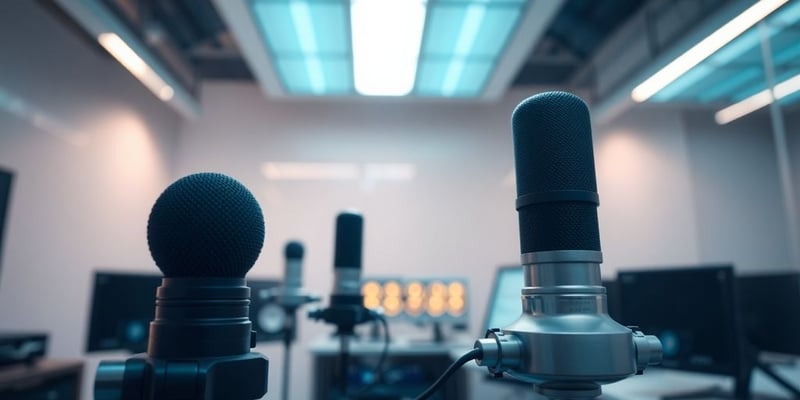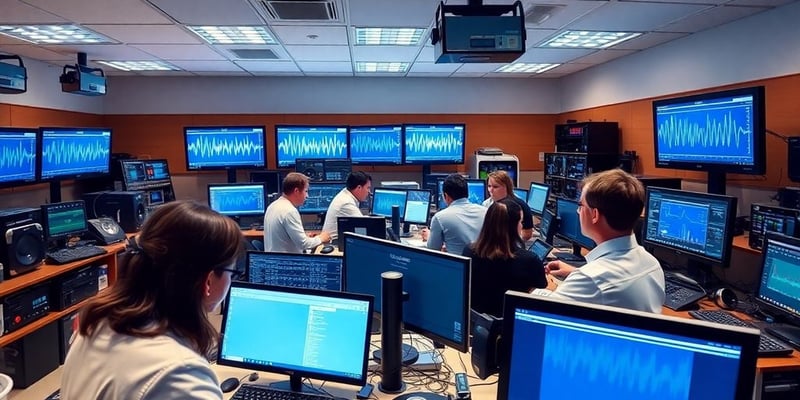
Exploring the Future of AI Labs Voice: Innovations in Speech Technology
Save 15%

AI Labs Voice is changing how we talk to our gadgets. It's not just about getting machines to understand us anymore. Now, it's about making them sound more human. From voice assistants to smart speakers, the way we interact with technology is getting a serious upgrade. And it's not just tech for tech's sake—these innovations are making life a bit easier and more connected.
Key Takeaways
- AI Labs Voice is pushing the boundaries of how machines can sound like humans.
- Voice synthesis technology is opening up new possibilities in industries like media and entertainment.
- Ethical challenges, such as privacy concerns, are critical as voice technology evolves.
- Real-world applications of AI voices are transforming accessibility and communication.
- The future of AI Labs Voice includes exciting prospects like live translations and personalized experiences.
The Evolution of AI Labs Voice Technology
From Speech Recognition to Voice Synthesis
AI voice technology has come a long way from its humble beginnings. Initially, it was all about getting machines to understand human speech. Remember when voice recognition first hit the scene? It was clunky and often misunderstood us. Fast forward a few decades, and now we've got voice synthesis, where machines not only understand but can also generate speech that sounds eerily human. This shift from just recognizing speech to creating it has opened up a world of possibilities. The journey from speech recognition to voice synthesis marked a pivotal moment in AI development.
Milestones in AI Voice Development
Let's talk milestones. The 1980s saw the birth of the first speech recognition systems, like the one developed at Bell Labs. It was groundbreaking at the time. Then came the late 20th century, when natural language processing (NLP) and deep learning started to reshape the landscape. Virtual assistants like Siri, Alexa, and Google Assistant? Game changers. These tools brought voice AI into our daily lives, making it mainstream. Each milestone has built upon the last, pushing the boundaries of what's possible.
- 1980s: First speech recognition systems developed
- Late 20th Century: NLP and deep learning advancements
- 2010s: Introduction of virtual assistants like Siri and Alexa
The Role of Deep Learning in Voice AI
Deep learning has been a game-changer for voice AI. It's like giving machines a brain that can learn and adapt. With deep learning, AI systems can now understand complex language patterns and even the nuances of human speech. This technology is what allows voice AI to not just respond to commands but to engage in meaningful conversations. It's the backbone of modern voice synthesis, making AI voices more natural and expressive. Deep learning has truly revolutionized how we interact with technology.
As voice AI continues to evolve, the integration of deep learning ensures that our interactions with machines become more seamless and intuitive. It's not just about understanding words, but capturing the essence of human communication.
In conclusion, the evolution of AI Labs Voice Technology isn't just about technological advancements; it's about changing how we communicate with machines on a fundamental level. Voice AI is revolutionizing business and customer interactions, enhancing connectivity beyond traditional software interfaces.
Innovations in AI Voice Synthesis
Advancements in Speech Synthesis Techniques
AI voice synthesis has come a long way, and recent advancements are making it even more exciting. Generative AI is at the forefront, pushing the boundaries of what's possible with voice technology. With neural vocoders leading the charge, AI voices are now more natural and expressive than ever. These new techniques allow for voices that closely mimic human speech, making virtual interactions feel more genuine. It's like having a conversation with a real person rather than a machine. The improvements in speech synthesis are not just about sounding human but also about understanding context and delivering emotion.
Emotion Recognition in AI Voices
One of the coolest things happening in AI voice tech is emotion recognition. Imagine an AI that not only talks but also understands how you feel. This is becoming a reality as AI systems learn to pick up on emotional cues in speech. This capability is crucial for applications like virtual assistants and automated customer service, where understanding the user's mood can lead to better interactions. Emotion-aware AI voices can adjust their tone and response based on the user's emotional state, creating a more personalized experience. It's like having a friend who knows when you're happy or upset and responds accordingly.
The Impact of Generative AI on Voice Technology
Generative AI is shaking up the world of voice tech. It's helping create voices that are not just realistic but also customizable to a user's preferences. This means you can have an AI voice that sounds just the way you want it to, whether it's for a personal assistant or a creative project. The impact of generative AI extends beyond just creating voices; it's opening up new possibilities for how we interact with machines. With generative AI, the line between human and machine communication is blurring, paving the way for more intuitive and natural interactions. This technology is not just about making voices sound good; it's about making them meaningful and engaging.
Real-World Applications of AI Labs Voice
Transforming the Voice Acting Industry
AI voice technology is shaking up the voice acting world. Traditionally, voice actors needed to be present in studios, spending hours perfecting their roles. Now, with AI, synthetic voices can mimic human emotions and nuances, offering a new tool for creators. This doesn’t mean voice actors are out of a job, though. Instead, they can collaborate with AI to produce content faster and more efficiently. This hybrid approach allows for more creativity and flexibility in projects, enabling actors to focus on more complex roles while AI handles repetitive tasks.
AI Voices in Audiobooks and Media
The audiobook and media sectors are benefiting significantly from AI voices. AI can produce high-quality, consistent narration for audiobooks, making it easier and cheaper to produce large volumes of content. This technology helps publishers meet the growing demand for audiobooks without compromising quality. In media, AI voices can be used for dubbing and voiceovers, providing a quick turnaround and allowing producers to localize content efficiently. This capability is especially beneficial for international markets, where content needs to be adapted to different languages and cultures.
Enhancing Accessibility with AI Voice
AI voice technology is a game-changer for accessibility. It offers solutions for individuals with disabilities, ensuring they can interact with technology seamlessly. For instance, voice commands allow users with limited mobility to control devices without physical interaction. Moreover, AI can convert text to speech, making digital content accessible to those with visual impairments. This technology is also being integrated into educational tools, helping students with learning disabilities by providing personalized and adaptive learning experiences.
The real-world applications of AI voice technology are vast and varied, offering new possibilities across industries. As AI continues to evolve, its integration into everyday life will likely expand, making interactions more intuitive and inclusive.
Ethical Considerations in AI Voice Technology

Privacy and Consent in Voice Cloning
Voice cloning is a remarkable technology, but it comes with its own set of ethical challenges. Ethical voice replication technology mandates obtaining explicit permission from individuals before cloning their voices. This ensures respect for personal privacy and prevents unauthorized use. Imagine if someone could clone your voice without your consent. Scary, right? That's why companies need to have strict guidelines in place to protect individuals' rights.
Addressing Bias in AI Voice Systems
Bias in AI voice systems is another significant concern. These systems can inadvertently favor certain accents or dialects, leading to unfair treatment. To tackle this, AI models should be trained with diverse data sets that include various accents and languages. This helps in creating a more inclusive technology that doesn't discriminate based on voice characteristics.
Regulatory Frameworks for Ethical AI
As AI voice technology continues to evolve, establishing regulatory frameworks becomes crucial. These regulations will ensure that AI is developed and deployed ethically across different sectors. It's not just about creating rules but also about enforcing them effectively. This includes setting standards for data privacy, consent, and the ethical use of AI-generated voices.
The future of AI voice technology holds immense potential, but with great power comes great responsibility. It's up to developers and regulators to ensure that this technology is used ethically and for the greater good.
The Future of AI Labs Voice in Global Communication
Live Voice Translation and Cross-Language Communication
In a world that's increasingly connected, the ability to communicate across language barriers is more important than ever. AI voice technology is stepping up to the plate with live voice translation capabilities. Imagine being able to hold a conversation with someone who speaks a different language, without missing a beat. It's not just a dream anymore. These advancements are making real-time communication across languages a reality, helping to bridge gaps and foster understanding between cultures.
AI Voice in Multilingual Environments
AI voice technology isn't just about translation; it's about creating environments where multiple languages can coexist seamlessly. In places like international conferences or multicultural workplaces, having an AI that can switch between languages effortlessly can be a game-changer. This technology can support a truly multilingual environment, allowing people to communicate in their preferred language without the usual misunderstandings that come from language barriers.
Fostering Global Connectivity with AI Voice
The world is more connected than ever, thanks in part to advances in AI voice technology. By breaking down language barriers, AI voice is helping to create a global community where ideas and information can flow freely. This technology is not just about communication; it's about connection. It's about bringing people together, no matter where they are in the world. As AI continues to evolve, we can expect these connections to become even stronger, fostering a sense of global unity.
Challenges and Opportunities in AI Voice Technology
Security Concerns and Deepfake Threats
AI voice tech is moving fast, and with that speed comes some real worries. One biggie is security. Imagine someone using your voice to access your bank account. That's not sci-fi; it's a legit threat. Deepfakes are another headache, letting people create realistic fake audio clips. This could mess with trust in media and personal interactions.
Balancing Innovation with Ethical Responsibility
While it's awesome to see new tech coming out, there's a fine line between cool and creepy. Companies need to be careful about how they use AI voice tech. It's not just about making something that works; it's about thinking through the impact. How do we make sure these tools are fair and don't discriminate? That's a question that needs answering.
Opportunities for Personalized Digital Experiences
On the flip side, AI voice tech opens up some sweet opportunities. Think about having a digital assistant that knows your preferences and can chat with you in a way that feels personal. Or imagine a learning tool that adapts to your pace and style. These are just a couple of ways AI voice tech could make digital experiences more tailored and engaging.
As AI voice technology evolves, we're standing at a crossroads. The potential for innovation is huge, but so are the ethical dilemmas. The key will be finding a balance that allows for growth while addressing the real concerns that come with it. This isn't just about tech; it's about shaping the future of how we communicate and interact with the world.
The Role of AI Labs Voice in Education and Learning

Personalized Learning with AI Voice
AI voice technology is making waves in education by tailoring learning experiences to fit individual student needs. Imagine a classroom where each student has a personal tutor that knows their strengths and weaknesses. AI voice systems can adjust the pace and style of teaching, ensuring that no student is left behind. This kind of personalized attention was once a dream, but now it's becoming a reality thanks to AI.
- AI can adapt lessons in real-time based on student responses.
- It can offer additional explanations for complex topics.
- Students can engage with interactive voice-based quizzes to reinforce learning.
AI Tutors and Educational Tools
AI tutors are not just a futuristic concept anymore. They're here, and they're helping students learn in ways that were unimaginable a few years ago. These AI-driven tools provide instant feedback, helping students correct mistakes on the fly. They can also simulate real-world scenarios, making learning more engaging and practical.
- AI tutors provide 24/7 availability, allowing students to learn at their own pace.
- They can offer a diverse range of subjects, from math to languages.
- These tools help in reducing the workload of teachers by handling repetitive tasks.
Bridging Language Gaps in Education
Language barriers have long been a hurdle in education, but AI voice technology is breaking down these walls. With AI's ability to translate and interpret languages in real-time, students from different linguistic backgrounds can learn together seamlessly. This not only improves understanding but also promotes cultural exchange in classrooms.
AI voice technology is not just changing how we learn; it's changing who can learn. By making education more accessible, it opens doors for students worldwide, regardless of their native language.
Incorporating AI voice technology in education is more than just a trend; it's a transformation. As these technologies continue to evolve, they hold the promise of making learning more inclusive and effective for everyone.
The Integration of AI Voice with Emerging Technologies
AI Voice in Augmented Reality and IoT
AI voice technology is weaving its way into the fabric of augmented reality (AR) and the Internet of Things (IoT), creating a more immersive and interactive experience. Imagine walking through a museum and having an AR device narrate the history of each exhibit in your preferred language, all through voice AI. This kind of integration not only makes the experience more engaging but also accessible to people from different linguistic backgrounds. The synergy between AI voice and IoT devices is transforming homes into smart ecosystems, where voice commands can control everything from lighting to security systems.
Voice-Enabled Smart Devices
Smart devices are getting smarter, thanks to AI voice technology. From smart speakers to refrigerators, these devices are now equipped with voice recognition capabilities that allow users to interact with them more naturally. You can ask your fridge about the weather or tell your speaker to play your favorite song. This shift not only enhances user convenience but also paves the way for more personalized digital experiences. By understanding user preferences and behaviors, these devices can offer suggestions that are tailored to individual needs.
The Future of Human-Machine Interaction
The way we interact with machines is changing dramatically, and AI voice is at the forefront of this evolution. As voice recognition becomes more advanced, the line between human and machine interaction continues to blur. Future developments might include machines that can understand not just words but the emotions behind them, leading to more empathetic and effective communication. This could revolutionize customer service, making interactions more human-like and responsive to emotional cues.
As AI voice continues to integrate with emerging technologies, the possibilities seem endless. We're stepping into a world where machines understand us better, making our interactions with technology more seamless and intuitive. This is just the beginning of a new era in human-machine collaboration.
Conclusion
AI voice technology is moving fast, and it's changing how we talk to machines and each other. Companies like 11 Labs are leading the way, making voices that sound more human and can show emotions. This tech isn't just for fun; it's helping in real ways, like making audiobooks or helping people who can't speak well. But with all this cool stuff comes some worries, like making sure people's voices aren't used without asking them first. As we keep pushing forward, it's important to be smart about how we use this technology, making sure it's safe and fair for everyone. The future looks exciting, with more personalized and interactive experiences on the horizon. Let's keep an eye on how this unfolds and make sure we're ready for the changes it brings.
Frequently Asked Questions
What is AI voice technology?
AI voice technology allows computers to understand and produce human-like speech. It's used in things like virtual assistants and voice-controlled devices.
How does AI voice synthesis work?
AI voice synthesis uses computer algorithms to create voices that sound like real people. It can mimic different tones, accents, and emotions.
Where is AI voice technology used?
It's used in many places like smart speakers, customer service, audiobooks, and even in helping people with speech difficulties.
What are the ethical concerns with AI voice?
There are worries about privacy and using someone's voice without permission. It's important to make sure AI is used responsibly.
Can AI voices sound just like real people?
Yes, some AI voices are so advanced that it's hard to tell them apart from real human voices.
How is AI voice helping with language learning?
AI voice can help by providing pronunciation examples, translating languages, and offering personalized learning experiences.









